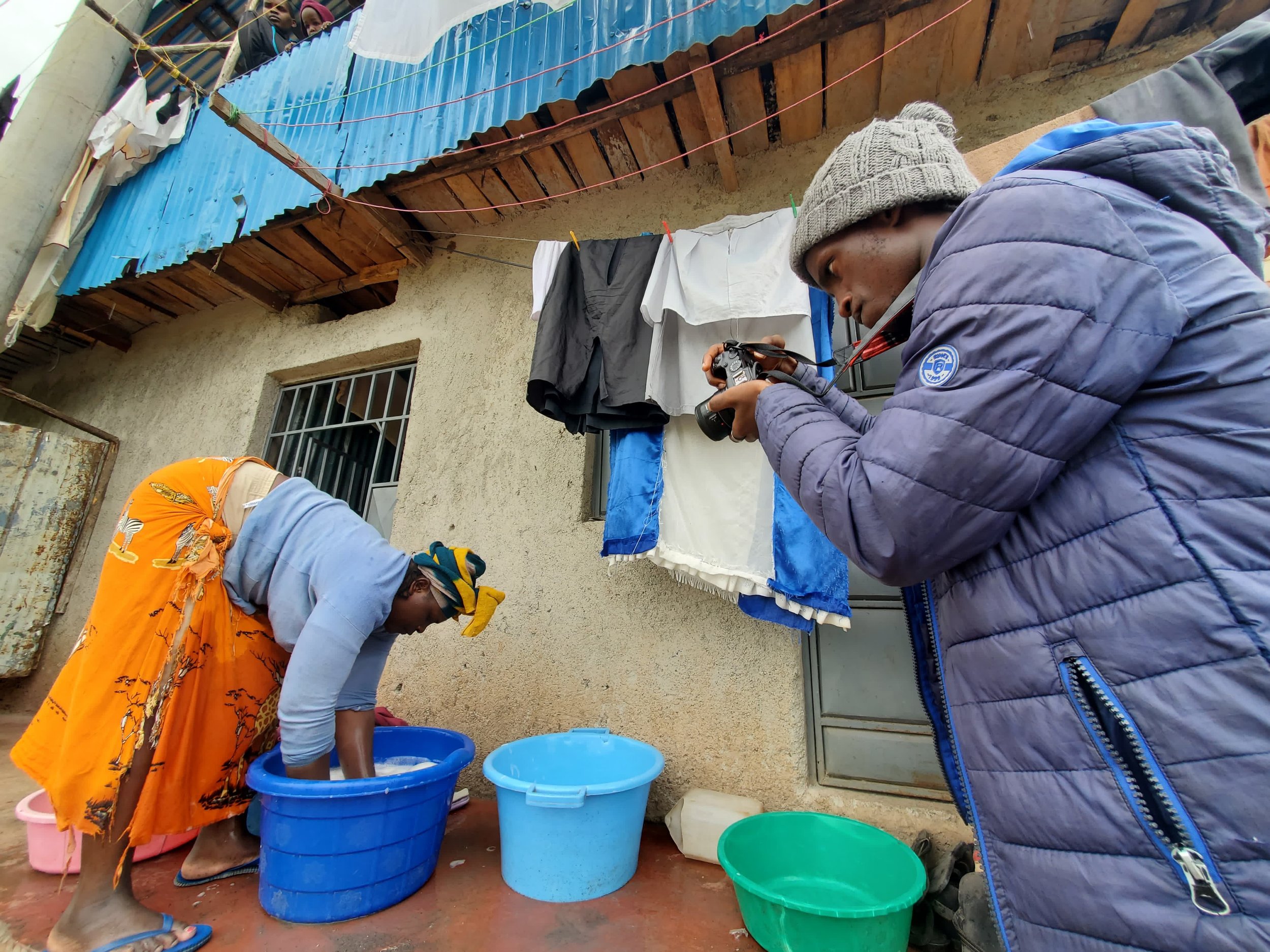Thanks to Peris Saleh of Mukuru Youth Initiative, located in Mukuru kwa Ruben, one of Nairobi’s many informal settlements, more commonly known as “slum” communities, for inviting us to work in Mukuru.
Special thanks to the Spartan Photography Kenya team of Dennis Onyango Otieno, Kevin Ochieng, Iddah Akinyi, Shawn Darrel Kalidou, and Dorine Biira for helping lead the workshop.
Prof. David Blumenkrantz in the Mukuru Youth Initiative classroom. This workshop focused mainly on the theory and practice of Advocacy Journalism, and the application of newly learned skills in camera operations and the elements of strong photographic compositions to real-life situations.
Dennis Onyango Otieno of Spartan Photography Kenya works with students, helping them become familiar with the workings of DSLR cameras, and the best way to approach subjects in the field.
The students showed great dedication and talent, producing several excellent photographs after only two weeks of instruction…several students were expected to submit their best images to the United Nations Focal Point on Youth, to be published in their annual “UN World Youth Report,” after a visit to our project by Nicola Shepherd, C-Chair of the UN Inter-Agency Network on Youth Development. Here, below, are some of the best images made in two short weeks of photography:
Mukuru resident Elvis Leshan, while very proud of his Masai heritage, lives the urban life, and quickly distinguished himself as among the most talented and self-driven members of our workshop. He responded to the challenge of writing a photo essay proposal based on the concepts of Advocacy Media approaches to photojournalism taught in this course with the writing seen here. His proposal was shared with the head of the Shofco Urban Network, that NGO’s media program, whose director deemed it so excellent that he agreed to guide Leshan, still very much a beginner, through the production process, and have the work published in their SUN Magazine.
Scenes from the classroom and out in the Mukuru community…
BACKGROUND INFORMATION ON THE ADVOCACY MEDIA & PHOTOJOURNALISM CURRICULUM
The Mukuru Youth Initiative workshop was implemented as a pilot project, representing an abbreviated version of source curriculum created by Prof. David Blumenkrantz of the CSUN Dept. of Journalism and One of Us Project. In our brief three week workshop we were only able to cover two of the five modules in the Advocacy Media & Photojournalism Curriculum, so we concentrated on Module B (Photojournalism skills and techniques) and Module C (Alternative Approaches to Media Reporting, ie; Advocacy Media).
The purpose of this program is to bring vocational training and communications skills, as well as an opportunity for artistic creativity, to the underserved communities in the informal settlements of Kenya. Providing residents of these communities with such skills will empower them to educate their neighbors on the key issues of health and well-being (with an emphasis on combatting climate change), build stronger communities, and reduce economic and gender inequality. We propose to begin this as a pilot program, teaching the eight courses over a four-month period, after which a full assessment of the efficiency and effectiveness will be conducted before expanding into more locations.
IMPACT
This project, which establishes a training/mentorship program with staff working with the underserved living in informal slum communities, addresses dire needs in three key areas:
1) Urban poverty and unemployment. Photography and multimedia have been identified as areas of vocational training that have the potential to lead to income-generating opportunities, commercially, artistically and in the fields of communications, journalism and advocacy.
2) Gender disparity. In Kenya as in other developing countries, it is undeniably the women who have historically bore the brunt of issues such as inequal access to education and skills training. Providing mentorship and training in writing, photography and editing skills will have the impact of empowering new generations of young women to have the knowledge and skills—traditionally the domain of men-- to confront and represent the challenges faced within their own communities.
3) Climate Change and its attendant impacts on the environment and health. Access to clean, fresh water is just one area in which climate change has already begun to affect life in the slums. This is an issue that especially affects women. The proposed curriculum features a practicum course on Climate Change, in the form of a team documentary project that will allow the participants/students in the program to synthesize the skills they have learned in writing, photography and videography into a meaningful result.
RATIONALE: THE ROLE OF JOURNALISM AND ADVOCACY MEDIA IN SOCIETY
Journalism and photojournalism are essential vocations that provide critical information to the public. Journalists play a vital role in keeping the public informed about current events, issues, and policies that affect them. Journalists are responsible for gathering information, conducting interviews, and investigating stories to provide objective, accurate, and unbiased news coverage. They serve as a bridge between the public and those in power, providing a voice for those who may not otherwise have one. Journalists also cover feature topics such as entertainment, sports and human-interest stories. Photojournalism uses images to tell these stories. It captures the essence of an event or situation in a way that words cannot. Photojournalists document history, culture, and the human experience, providing a visual record that can inform and inspire. Both journalism and photojournalism are essential for a healthy democracy. They provide a platform for different voices and perspectives, and they facilitate public discourse, enabling individuals to make informed decisions about their lives and communities. Advocacy media can represent a wide range of viewpoints and issues. Examples of advocacy media include activist blogs and websites dedicated to specific causes or interest groups. Training in this area can lead to employment opportunities in the vast nonprofit and NGO industries that exist in Kenya and have a particularly large presence and impact in the communities where these courses will be taught.




















































































